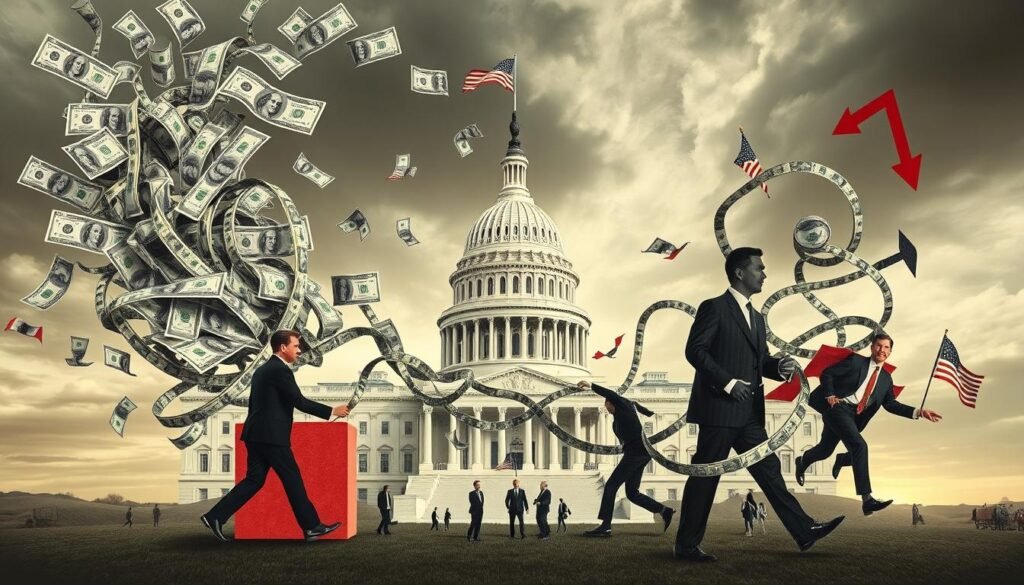The Influence of Political Action Committees in Advocacy
Over 4,600 Political Action Committees (PACs) are active, as shown by the Federal Elections Commission (FEC). This shows how important PACs are in shaping Advocacy Groups and politics. PACs collect money from people or groups to back candidates, parties, or causes. They are key players in the political world.
It’s vital to understand PACs to get the full picture of today’s politics and advocacy. As Advocacy Groups grow, PACs are essential. They help these groups spread their message and support candidates who share their views.
Key Takeaways
- PACs are organizations that pool money to support candidates, parties, or causes.
- There are over 4,600 active PACs registered with the FEC.
- PACs can contribute up to $5,000 to a candidate committee per election.
- Super PACs can raise and spend unlimited funds but cannot coordinate with candidate campaigns.
- PACs must comply with ongoing periodic reporting obligations and follow rules for disclaimers on communications.
- PACs have contributed significantly to election campaigns, with over $1.1 billion raised during the 2020 election cycle.
- Advocacy Groups rely on PACs to amplify their message and support like-minded candidates.
Understanding Political Action Committees (PACs): Core Concepts
Political Action Committees (PACs) are key in Campaign Financing, Lobbying Organizations, and Political Advocacy. Knowing about PACs means understanding their role, structure, types, and legal rules. The Federal Election Commission (FEC) oversees all PAC money, making sure everything is clear and follows the law.
PACs fall into different groups, like separate funds and non-connected ones. Separate funds come from companies, unions, and more, getting money from members or employees. Non-connected PACs, though, focus on certain ideas or issues, not tied to big groups or parties.
Definition and Basic Structure
A PAC is a group that helps support candidates for Congress with money and learning. The law limits how much one person can give to a PAC.
Types of Political Action Committees
There are over a thousand non-connected PACs, each with its own focus. Super PACs, born after a big court decision, can take unlimited money to help candidates. Leadership PACs help politicians fund their own races and support others.
Legal Framework and Regulations
Managing PACs is tricky because of different laws in each state. Some states let companies give money, while others don’t. This shows why knowing local rules is important. The FEC makes sure PACs are open about their money, keeping things honest and fair.
Historical Evolution of PACs in American Politics
The story of Political Action Committees (PACs) in the U.S. is one of growth and Political Influence. The first PAC came from the labor movement in the 1940s and 1950s. Today, PACs are key in American politics, with their PAC Contributions shaping the country’s agenda.
PACs raised $333 million in 1990 and jumped to $482 million in 2022. This shows how important PACs have become in U.S. politics. The Supreme Court’s Citizens United ruling in 2010 made it easier for PACs to raise money, boosting their Political Influence.
The top ten PACs in the 2020 election gave $28,276,448. This shows the big role PAC Contributions play in politics. Understanding PACs’ history is key to grasping their impact on American politics.
Important milestones include the rise of Super PACs, which can take unlimited PAC Contributions. The Speechnow.org v. FEC ruling in 2010 allowed for these groups. This gave corporations and unions the chance to donate freely, increasing PACs’ Political Influence.
The Role of Political Action Committees in Modern Advocacy
Political Action Committees (PACs) are key in today’s advocacy world. They give money to candidates and causes and help get people involved. PACs are vital for making a big difference in politics.
PACs help fund campaigns by supporting candidates who share their views. They also push for issues they care about, getting people to join in. By using different Advocacy Strategies, PACs can change policies and shape what politicians talk about.
Some important things about PACs in today’s advocacy are:
- Campaign finance contributions: PACs give money to help candidates run their campaigns.
- Issue-based advocacy: PACs get people to support certain issues through lobbying and ads.
- Grassroots mobilization: PACs get citizens involved in politics, making their voices heard.
In summary, Political Action Committees are very important in today’s advocacy. They help with money, get people involved, and shape policies. Knowing about PACs helps people understand politics and advocacy better.
| PAC Activity | Description |
|---|---|
| Campaign Finance Contributions | Financial support to candidates and parties |
| Issue-based Advocacy | Mobilizing public support for specific issues |
| Grassroots Mobilization | Engaging citizens in the political process |
How PACs Shape Political Discourse
PACs have a big role in politics. They help shape what people think and what laws are made. They give millions to candidates and parties. Lobbying organizations also help them out, pushing for their interests.
Some interesting facts show how big PACs are:
- Total contributions from 43 health care PACs in the 2010 and 2012 election cycles amounted to $41.0 million.
- Of this total, $20.2 million (49.2%) was donated to Democratic candidates.
- Physician-affiliated PACs contributed $25.8 million, of which $14.1 million (54.8%) went to Republican candidates.
PACs also play a big part in making laws. For example, the ACA vote in the Senate was 60 to 39. Democrats voted all together, while Republicans voted no. In the House, it was 219 to 212, with 34 Democrats voting with Republicans.
In short, PACs really shape what we talk about in politics. Their influence in politics is clear. As lobbying organizations keep working with PACs, it’s key to know their role in making laws and shaping what we think.
| PAC Type | Total Contributions | Contributions to Democrats | Contributions to Republicans |
|---|---|---|---|
| Health Care PACs | $41.0 million | $20.2 million | $20.8 million |
| Physician-Affiliated PACs | $25.8 million | $11.7 million | $14.1 million |
Financial Impact and Campaign Contributions
PACs have a big impact on campaigns, shaping the political scene. They help candidates by pooling resources. This way, they support those who share their interests.
The FEC tracks PAC money, starting from audits and complaints. They also look at referrals from other agencies. The FEC has a program for fines for late or missing reports.
Here are some important points about PAC Contributions and Campaign Financing:
- PACs can give money to candidates, parties, and other PACs. But there are rules to stop them from having too much power.
- The FEC makes sure campaign finance laws are followed. They handle all civil cases related to these laws.
- PACs must report their money activities. They do this by filing reports with the state election body. This makes their spending and donations clear.
In summary, PAC Contributions and Campaign Financing are key in politics. They have a big effect on how campaigns and elections turn out. Knowing the rules and reporting needs for PACs is vital in the complex world of campaign finance.
| PAC Type | Contribution Limit | Reporting Requirement |
|---|---|---|
| Federal PAC | $5,000 per candidate per election | File periodic financial activity reports with the FEC |
| State PAC | Varies by state | File periodic financial activity reports with the state election body |
Strategies and Techniques in PAC Advocacy
PACs use many Advocacy Strategies to reach their goals. These include lobbying, getting people involved, and giving money to campaigns. These actions help PACs have a big impact on politics.
Some key Advocacy Strategies used by PACs are:
- Building strong relationships with lawmakers and their teams
- Supporting candidates financially who match their interests
- Starting grassroots efforts to make people aware of important issues
By using these strategies, PACs can grow their Political Influence. For instance, keeping up with election changes helps PACs adjust their plans. This way, they can better meet their goals.
PACs also use creative ways to raise money. This includes online appeals, email campaigns, and asking people directly. These methods help PACs fund their efforts and boost their Political Influence.
| Fundraising Technique | Effectiveness |
|---|---|
| Online Solicitation | 91% of PAC managers use this technique |
| Email Campaigns | 64% of PAC managers find this the most effective |
| Peer-to-Peer Solicitation | 67% of corporate PACs use this technique |
The Relationship Between PACs and Political Parties
Political Action Committees (PACs) are key players in politics. They often align with party values, backing candidates who match their goals. This support can greatly affect election results through independent expenditures.
PACs also build coalitions with other groups to boost their power. They team up with Lobbying Organizations for more influence. This shows how PACs and parties work together in complex ways.
- PACs can take up to $5,000 a year from any person.
- They can give $5,000 to a candidate and $15,000 to party committees per election.
- Super PACs can get unlimited donations, even from unions and corporations.
Looking at PACs and parties helps us see their big role in politics. It shows how PACs and Lobbying Organizations shape our political world.
Critical Analysis: Benefits and Controversies
The role of Advocacy Groups in politics is complex. Both supporters and critics have strong points. Advocacy Groups can help people get involved in politics. This makes citizens more informed and active, which is good for democracy.
But, some say Advocacy Groups can also harm politics. They might focus too much on special interests. This can make some groups have more power than others. To fix this, some suggest making Advocacy Groups more open and responsible.
Important things to think about include:
- Transparency: Advocacy Groups should be clear about their money and actions.
- Accountability: They should be responsible for their effects on politics.
- Representation: They should really listen to their members, not just special groups.
The link between Advocacy Groups and politics is complex. We need to look at both sides. By understanding this, we can better see how Advocacy Groups shape our political world.
Super PACs: Evolution and Impact
Super PACs have grown a lot, giving $4,214,707,961 to federal election campaigns. This shows how much they affect Campaign Financing. But, not knowing who gives them money raises big questions about PAC Contributions transparency.
Super PACs can take unlimited money from donors without saying who they are. This has made people question their role in elections. For example, the top 10 Super PACs in 2020 spent over $1 billion. This shows how big their role in Campaign Financing is.
Some Super PACs are key in supporting certain candidates or causes. Restore Our Future, for Mitt Romney in 2012, spent over $142 million. Most of it was on ads against Barack Obama. Priorities USA Action, for Joe Biden in 2020, also spent millions on ads and outreach in key states.
Super PACs affect more than just federal elections. They also play big roles in state campaigns and ballot issues. Their role in PAC Contributions and Campaign Financing is very important. It has big effects on our democracy.
| Super PAC | Candidate/Cause | Expenditure |
|---|---|---|
| Restore Our Future | Mitt Romney | $142 million |
| Priorities USA Action | Joe Biden | Millions |
| Senate Leadership Fund | Republican Senate candidates | $190 million |
Future Trends in Political Action Committee Advocacy
Politics and advocacy are changing fast, and Political Action Committees (PACs) are keeping up. They’re using new Advocacy Strategies that include digital tools. This helps them work better and have more impact.
PACs are now seeing how important digital tools are. They use them for online fundraising and social media. They plan to use even more digital tools to boost their Political Influence. Some areas they’re focusing on include:
- Digital fundraising and donor engagement
- Social media and online advocacy campaigns
- Data analytics and targeting
PACs face new rules and changing public views. But by using digital tools and smart Advocacy Strategies, they can stay strong. This way, they can keep their Political Influence in the future.
| Trend | Description |
|---|---|
| Digital Fundraising | Online platforms and tools for fundraising and donor engagement |
| Social Media Advocacy | Using social media to mobilize supporters and influence policy |
| Data Analytics | Using data to target and engage key audiences and stakeholders |
Conclusion: The Enduring Influence of PACs in American Democracy
Political Action Committees (PACs) play a big role in American politics. They make big contributions to campaigns and push for certain issues. This has a big impact on how politics works and who wins elections.
Many people don’t trust the government as much anymore. They worry that money from the rich and special groups is too powerful. But, PACs keep finding ways to stay important in politics. They change how they work as the rules about money in politics change.
The role of PACs in our democracy is complex. Some people think they’re good, while others see them as bad. Knowing how PACs work helps us make better choices in politics. As PACs keep changing, they will keep shaping American politics for a long time.
FAQ
What are Political Action Committees (PACs)?
What are the different types of PACs?
How do PACs influence the political landscape?
What are the financial regulations governing PACs?
How have PACs evolved over time in American politics?
What are the key strategies and techniques used by PACs in their advocacy efforts?
How do PACs interact with political parties?
What are the benefits and controversies surrounding PACs?
How have Super PACs impacted the political landscape?
What are the future trends in PAC advocacy?
Source Links
- Political Action Committees | Hurwit & Associates
- Facts about PACs: The role of political programs and the importance of engagement
- What is a Political Action Committee (PAC)?
- Understanding Political Action Committees with NABPAC
- Political action committee (PAC) | Britannica
- ASCLS Political Action Committee – ASCLS
- What Is a Super PAC? A Short History
- Political action committee
- What is the Role of Political Action Committees (PACs)?
- ADVOCACY IN ACTION: ASCLS POLITICAL ACTION COMMITTEE (PAC) FREQUENTLY ASKED QUESTIONS – ASCLS
- ACSA’s PAC: Who, What and Where
- Professional Societies, Political Action Committees, and Party Preferences
- PAC vs Super PAC: What is the Difference? | Quorum
- Advocacy, Lobbying, and Political Activities
- Introduction to campaign finance and elections – FEC.gov
- Legislative Capital: A Guide for State Association Political Action Committees
- Tap the Power of PACs to Advance Your Advocacy Goals
- Keys to Successful Advocacy: Political Action – Association Adviser
- 10 Fundraising Ideas for Political Action Committees
- PACs, Super PACs and More: Your Guide to Key Election Spending Vehicles
- The Importance of Professional Advocacy at the State Level: A Coalition Model
- Policy Advocacy and Nursing Organizations: A Scoping Review
- Super PACs: Where They Came from and What We Know About Dark Money Seven Years Later
- Day 84: Understanding Political Action Committees (PACs) and Citizens United
- Political Priorities, Voting, and Political Action Committee Engagement of Emergency Medicine Trainees: A National Survey
- American Medical Association Political Action Committee: How does the AMA affect health care policy?
- Political action committee data summary tables – FEC.gov
- Money in Politics: Campaign Finance and Its Influence Over the Political Process and Public Policy, 52 UIC J. Marshall L. Rev. 185 (2018)
- Campaign Finance
- NRSC v. FEC Corrected Opinion – 09/05/2024
























